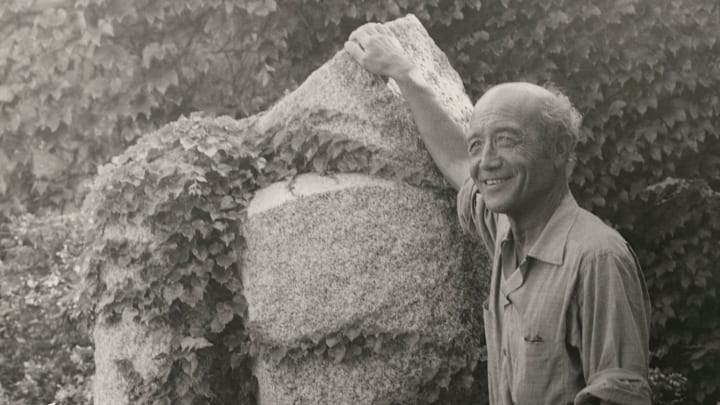Isamu Noguchi (1904–1988) was one of the most influential designers and sculptors of the 20th century. He was born in Los Angeles in 1904 to a Japanese father and American mother, both writers who instilled the importance of creativity into him from an early age. Here are eight facts about this crucial figure in the history of design.
BORN | DIED |
|---|---|
November 17, 1904, Los Angeles, California | December 30, 1988, New York, New York |
1. Isamu Noguchi was not given a name at birth—and did not receive one officially until he was 2 years old.

Noguchi’s parents were physically separated when he was born, with his father Yone living in Japan and his mother Léonie in the United States. His mother did not give him a name at birth because she was waiting—by letter—to hear Yone’s thoughts on the subject. The two parents corresponded for some time on this issue, and on the question of mother and son coming to Japan to reunite with Yone. Léonie and her son finally made the move in 1907, after which the young Noguchi was formally given the name Isamu.
2. Noguchi apprenticed for the sculptor Constantin Brâncuși in his early twenties.

In 1926, Noguchi saw an exhibition by the sculptor Constantin Brâncuși that he greatly admired. He was able to meet with Brâncuși in person and secure a five-month apprenticeship in Paris the following year; the Romanian artist would go on to become arguably one of the most important influences on Noguchi’s work.
3. Noguchi’s coffee table is one of the most iconic pieces of modern furniture design.
In 1939, Noguchi designed a coffee table that would later become one of the 20th century’s most influential pieces of furniture. The original design was rosewood and glass, and the sculpture-like object stood on only three legs. After World War II, Noguchi returned to this design and developed it further, creating a slightly different structure with a glass top on a three-legged base. The unusual piece became incredibly popular, and is one of the designs with which he was most associated—it was even dubbed the “Noguchi Table.”
4. Noguchi once had a romantic relationship with the artist Frida Kahlo.

In the mid-1930s, Noguchi traveled to Mexico to work on a mural. During his trip, he met the painter Frida Kahlo, and they began a love affair. It was intense but relatively brief—Kahlo’s husband, Diego Rivera, was rather jealous and once chased Noguchi from their house while wielding a gun. Despite this, Noguchi and Kahlo stayed on good terms; they remained friends for the rest of her life.
5. Noguchi voluntarily entered an incarceration camp for Japanese American people during World War II.
During the Second World War, around 120,000 Japanese American citizens were imprisoned at incarceration camps across the U.S. Noguchi himself was not subjected to this because he lived in New York, which was exempt from the executive order. Yet he decided to voluntarily enter a camp to show solidarity with his fellow Japanese Americans and attempt to improve living conditions for them. However, his efforts were met with suspicion, and when he later attempted to leave, the authorities did not allow him to do so for several months.
6. Noguchi had a multi-decade collaboration with the dancer Martha Graham.

Noguchi met the dancer and choreographer Martha Graham in 1929; she commissioned him to make a sculptural portrait for her. This began a long and fruitful collaboration: Noguchi designed sets for Graham’s performances for three decades, encompassing more than 20 sets for the theater.
7. Noguchi designed a sculpture intended to be seen from Mars.
One of his most ambitious projects saw Noguchi extending his vision beyond Earth itself. In 1947, feeling disturbed by the nuclear age and the threat to the existence of humanity, he designed a sculpture that was intended to act as a monument to human existence—and to be able to be viewed from Mars. The sculpture was never built, however, and only a photograph of a model of it exists today [PDF].
8. A bank’s destruction of one of his works led to a public outcry about artists’ rights.

In 1975, Noguchi created a 17-feet long sculpture titled Shinto for the Bank of Tokyo Trust Company near Wall Street. Controversy ensued in 1980 when the bank decided to destroy the sculpture by breaking it into pieces and putting it into storage (they claimed that customers found its vast presence in the lobby too frightening). This led to a public outcry about the rights of artists in determining whether or not they should have a say in the fate of artworks they create on commission for others. Three years later, legislation was introduced in New York that gave artists the right to sue when they believed changes made to their works had damaged their reputations, a law that came about partly in the aftermath of the Shinto controversy.
